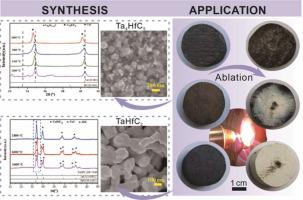Journal of Alloys and Compounds ( IF 5.8 ) Pub Date : 2021-11-28 , DOI: 10.1016/j.jallcom.2021.162989 Jun Cheng 1 , Zhijun Dong 1 , Hui Zhu 1 , Guanming Yuan 1 , Aidan Westwood 2 , Ye Cong 1 , Baoliu Li 1 , Jianguang Guo 1 , Xuanke Li 1

|
Ultra-fine Ta4HfC5 and TaHfC2 powders were prepared through the pyrolysis of a precursor synthesised by using a facile one-pot reaction. HfCl4, TaCl5, and phenolic resins were used as the sources of hafnium (Hf), tantalum (Ta), and carbon (C), respectively. The as-synthesised precursors were further utilised to prepare Ta4HfC5- and TaHfC2-modified carbon/carbon (C/C-Ta4HfC5 and C/C-TaHfC2) composites through precursor infiltration and pyrolysis. The transformation of Ta4HfC5 and TaHfC2 precursors into ultra-fine ceramic powders and anti-ablation performance of the C/C-Ta4HfC5 and C/C-TaHfC2 composites were investigated. The carbothermal reduction of Ta2O5 and Hf6Ta2O17 and the solid solution reaction between HfC and TaC occur successively during the pyrolysis of Ta4HfC5 precursors. HfC and TaC undergo a sufficient solid solution reaction at 1800 °C to form the Ta4HfC5 solid solution with a particle size of 200–300 nm. The pyrolysis products of TaHfC2 precursors acquired at 1400–1600 °C are composed of TaC, HfC and TaHfC2. High-temperature pyrolysis promotes the solid solution reaction between TaC and HfC. The TaHfC2 solid solution with a particle size of 100–150 nm is formed at 1800 °C. The introduction of TaHfC2 and Ta4HfC5 solid solutions into the C/C composite substantially enhances their anti-ablation performance. The linear ablation rates of C/C-Ta4HfC5 and C/C-TaHfC2 are 11.04 and 16.97 μm/s, respectively, which are considerably lower than that of the C/C composite. The good anti-ablation performance of the C/C-Ta4HfC5 and C/C-TaHfC2 composites can be attributed to the formation of the Ta2O5 and Hf6Ta2O17.
中文翻译:

通过简单的一锅反应合成和陶瓷化 Ta4HfC5 和 TaHfC2 超细粉末的有机金属前驱体
超细Ta 4 HfC 5和TaHfC 2粉末是通过使用简便的一锅反应合成的前体的热解制备的。HfCl 4、TaCl 5和酚醛树脂分别用作铪(Hf)、钽(Ta)和碳(C)的来源。合成的前驱体通过前驱体渗透和热解进一步用于制备Ta 4 HfC 5 - 和TaHfC 2 -改性的碳/碳(C/C-Ta 4 HfC 5和C/C-TaHfC 2)复合材料。Ta 4 HfC 5和TaHfC 2的转化研究了制备超细陶瓷粉末的前驱体以及C/C-Ta 4 HfC 5和C/C-TaHfC 2复合材料的抗烧蚀性能。Ta 2 O 5和Hf 6 Ta 2 O 17的碳热还原以及HfC和TaC之间的固溶反应在Ta 4 HfC 5前驱体的热解过程中相继发生。HfC 和 TaC 在 1800 °C 下发生充分的固溶反应,形成粒径为 200-300 nm的 Ta 4 HfC 5固溶体 。TaHfC 2的热解产物在 1400–1600 °C 下获得的前体由 TaC、HfC 和 TaHfC 2 组成。高温热解促进了 TaC 和 HfC 之间的固溶反应。在 1800 °C 形成粒径为 100-150 nm的 TaHfC 2固溶体 。将TaHfC 2和Ta 4 HfC 5固溶体引入C/C复合材料中,大大提高了它们的抗烧蚀性能。C/C-Ta 4 HfC 5和C/C-TaHfC 2的线性烧蚀速率分别为11.04和16.97 μm/s,远低于C/C复合材料。C/C-Ta 4 HfC 5良好的抗烧蚀性能和C/C-TaHfC 2复合材料可归因于Ta 2 O 5和Hf 6 Ta 2 O 17 的形成。































 京公网安备 11010802027423号
京公网安备 11010802027423号